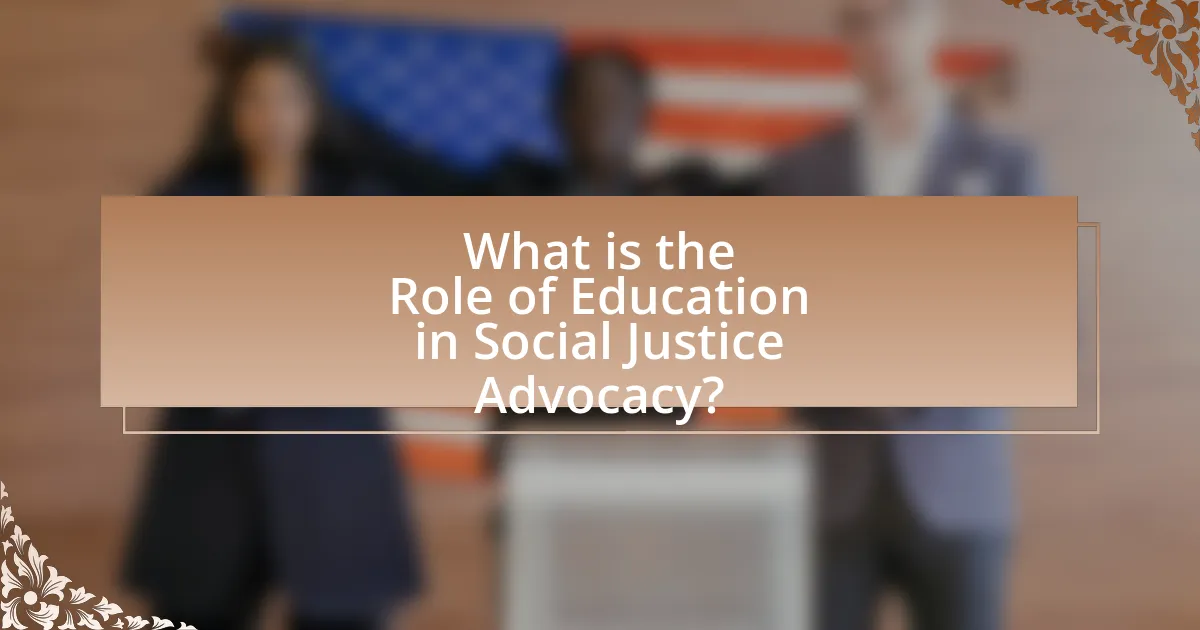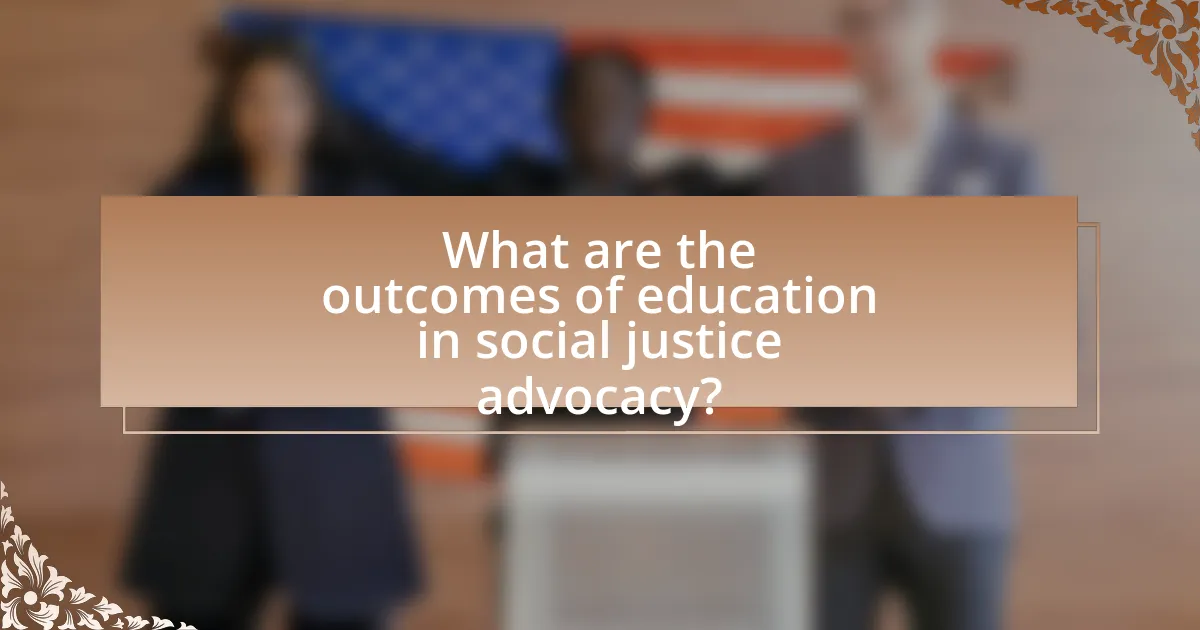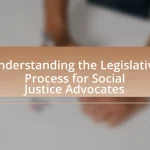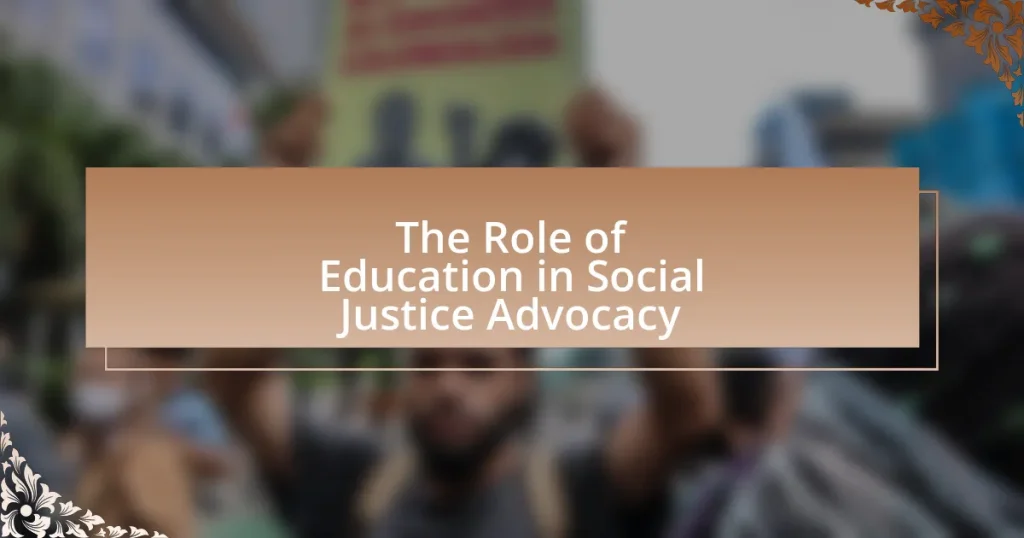The article examines the critical role of education in social justice advocacy, emphasizing how it empowers individuals to challenge systemic inequalities through knowledge and critical thinking. It discusses the connection between education and civic engagement, highlighting key educational principles such as equity, inclusivity, and critical pedagogy that support social justice. The article also addresses historical examples of education’s impact on social justice movements, the challenges faced in integrating social justice into educational systems, and the skills students gain that contribute to advocacy efforts. Additionally, it outlines best practices for educators to enhance their role in promoting social justice within their curricula and communities.

What is the Role of Education in Social Justice Advocacy?
Education plays a crucial role in social justice advocacy by empowering individuals with knowledge and critical thinking skills necessary to challenge systemic inequalities. Through education, individuals learn about their rights, the history of social movements, and the mechanisms of oppression, which equips them to advocate for change. For instance, studies show that education increases civic engagement; a report by the National Conference on Citizenship found that individuals with higher education levels are more likely to participate in community service and advocacy efforts. This connection between education and active participation in social justice initiatives underscores the importance of educational programs that focus on social equity and justice.
How does education contribute to social justice advocacy?
Education contributes to social justice advocacy by equipping individuals with critical thinking skills and knowledge about social inequalities. This foundational understanding enables advocates to identify injustices and mobilize communities for change. Research indicates that educational programs focused on social justice increase awareness of systemic issues, such as racism and economic disparity, fostering a sense of agency among learners. For instance, studies show that students engaged in social justice curricula are more likely to participate in activism and community service, demonstrating the direct impact of education on advocacy efforts.
What are the key educational principles that support social justice?
Key educational principles that support social justice include equity, inclusivity, critical pedagogy, and empowerment. Equity ensures that all students have access to the same educational opportunities, regardless of their background, which is essential for addressing systemic inequalities. Inclusivity promotes a learning environment where diverse perspectives are valued and all students feel represented, fostering a sense of belonging. Critical pedagogy encourages students to question societal norms and injustices, enabling them to become active participants in their education and advocates for change. Empowerment focuses on equipping students with the skills and knowledge necessary to challenge oppression and advocate for their rights and the rights of others. These principles are supported by research indicating that equitable and inclusive educational practices lead to improved student outcomes and greater social cohesion.
How does critical pedagogy influence social justice education?
Critical pedagogy significantly influences social justice education by promoting critical consciousness among learners, enabling them to recognize and challenge societal inequalities. This approach encourages students to engage in dialogue about power dynamics, privilege, and oppression, fostering an environment where they can critically analyze their own experiences and the structures that shape them. Research by Paulo Freire, a foundational figure in critical pedagogy, emphasizes the importance of education as a practice of freedom, where learners become active participants in their own learning and advocates for social change. This transformative process equips students with the tools necessary to address injustices and work towards a more equitable society.
Why is education considered a tool for social change?
Education is considered a tool for social change because it empowers individuals with knowledge and skills necessary to challenge societal norms and injustices. By providing access to information and critical thinking skills, education enables people to question existing power structures and advocate for equity. Historical evidence shows that educational initiatives, such as the civil rights movement in the United States, significantly contributed to social reform by raising awareness and mobilizing communities for change. Furthermore, studies indicate that higher levels of education correlate with increased civic engagement and participation in democratic processes, reinforcing the role of education in fostering social transformation.
What historical examples illustrate education’s impact on social justice?
Education has historically played a crucial role in advancing social justice, as seen in the Civil Rights Movement in the United States. During this period, initiatives like the Freedom Schools aimed to educate African American children and adults about their rights and the importance of civic engagement, significantly contributing to voter registration and activism. Additionally, the landmark Brown v. Board of Education Supreme Court case in 1954 declared racial segregation in public schools unconstitutional, which was a pivotal moment in the fight for equality and social justice. These examples demonstrate how education has been instrumental in challenging systemic inequalities and empowering marginalized communities.
How do educational institutions promote social justice initiatives?
Educational institutions promote social justice initiatives by integrating social justice principles into their curricula, fostering inclusive environments, and engaging in community outreach. For instance, many universities offer courses focused on equity, diversity, and inclusion, which educate students about systemic inequalities and empower them to advocate for change. Additionally, schools often implement policies that support underrepresented groups, such as scholarships for marginalized students and training programs for faculty on cultural competency. Research from the American Educational Research Association indicates that such initiatives can lead to increased awareness and activism among students, demonstrating the effectiveness of educational institutions in advancing social justice.

What are the challenges faced in integrating education with social justice advocacy?
Integrating education with social justice advocacy faces several challenges, primarily including systemic inequities, resistance to change, and lack of resources. Systemic inequities in educational institutions often perpetuate social injustices, making it difficult to implement curricula that promote equity and inclusion. Resistance to change from stakeholders, such as educators and policymakers, can hinder the adoption of social justice principles in educational settings. Additionally, a lack of resources, including funding and training for educators, limits the ability to effectively integrate social justice advocacy into educational programs. These challenges are supported by research indicating that educational systems often reflect broader societal inequalities, which complicates efforts to align education with social justice goals.
What barriers exist in educational systems that hinder social justice?
Barriers in educational systems that hinder social justice include inequitable funding, systemic racism, and lack of access to quality resources. Inequitable funding leads to disparities in educational opportunities, as schools in affluent areas receive more financial support compared to those in low-income neighborhoods. Systemic racism manifests in biased curricula and disciplinary practices that disproportionately affect marginalized students. Additionally, lack of access to quality resources, such as experienced teachers and advanced coursework, further exacerbates educational inequalities. According to the National Center for Education Statistics, schools serving predominantly students of color often have fewer advanced placement courses and less experienced educators, highlighting the systemic issues that impede social justice in education.
How do socioeconomic factors affect access to quality education?
Socioeconomic factors significantly affect access to quality education by creating disparities in resources, opportunities, and support systems available to students. Families with higher income levels can afford better educational resources, such as tutoring, extracurricular activities, and advanced technology, which enhance learning experiences. In contrast, lower-income families often face challenges such as underfunded schools, limited access to experienced teachers, and fewer educational materials, leading to poorer educational outcomes. For instance, a report by the National Center for Education Statistics indicates that schools in low-income areas receive about 15% less funding than those in wealthier districts, directly impacting the quality of education provided. Additionally, socioeconomic status influences parental involvement, with higher-income parents more likely to engage in their children’s education, further widening the achievement gap.
What role does policy play in shaping educational equity?
Policy plays a crucial role in shaping educational equity by establishing frameworks that govern access to resources, funding, and opportunities within educational systems. Effective policies can address disparities by mandating equitable distribution of funding, implementing inclusive curricula, and ensuring that marginalized communities receive adequate support. For instance, the Every Student Succeeds Act (ESSA) in the United States aims to provide all students, regardless of their background, with access to high-quality education, thereby promoting equity. Research indicates that states with strong equity-focused policies see improved educational outcomes for disadvantaged students, highlighting the direct impact of policy on educational equity.
How can educators effectively advocate for social justice?
Educators can effectively advocate for social justice by integrating social justice principles into their curriculum and fostering an inclusive classroom environment. This approach involves teaching students about systemic inequalities, encouraging critical thinking, and promoting empathy through diverse perspectives. Research indicates that when educators incorporate social justice education, students demonstrate increased awareness of social issues and a greater commitment to civic engagement (Sleeter, 2011, “The Academic and Social Value of Social Justice Education,” Harvard Education Press). By actively participating in community initiatives and collaborating with local organizations, educators can also amplify their advocacy efforts, creating real-world connections that enhance students’ understanding of social justice.
What teaching strategies promote social justice awareness among students?
Teaching strategies that promote social justice awareness among students include critical pedagogy, culturally relevant teaching, and project-based learning. Critical pedagogy encourages students to question societal norms and injustices, fostering a critical consciousness about social issues. Culturally relevant teaching connects the curriculum to students’ cultural backgrounds, making learning more relatable and empowering. Project-based learning engages students in real-world problems, allowing them to explore social justice issues actively. Research by Paulo Freire emphasizes the importance of dialogue and reflection in education to cultivate awareness and action against oppression.
How can educators engage with communities to foster social change?
Educators can engage with communities to foster social change by implementing collaborative projects that address local issues. For instance, educators can partner with community organizations to create service-learning opportunities, allowing students to apply their knowledge to real-world challenges. Research shows that such engagement not only enhances student learning but also strengthens community ties; a study by the National Service-Learning Clearinghouse found that service-learning increases civic engagement and social responsibility among students. Additionally, educators can facilitate community forums to discuss social justice topics, empowering community members to voice their concerns and collaborate on solutions. This approach aligns with the principles of social justice advocacy, promoting equity and inclusivity within the educational framework.

What are the outcomes of education in social justice advocacy?
Education in social justice advocacy leads to increased awareness of social inequalities, enhanced critical thinking skills, and the development of advocacy strategies. These outcomes empower individuals to recognize systemic injustices and mobilize for change. For instance, studies show that educational programs focused on social justice can significantly improve participants’ understanding of issues such as racism, gender inequality, and economic disparity, fostering a commitment to activism. Additionally, research indicates that individuals educated in social justice advocacy are more likely to engage in community organizing and policy reform efforts, demonstrating the practical impact of such education on societal change.
How does education empower marginalized communities?
Education empowers marginalized communities by providing them with knowledge, skills, and opportunities that enhance their social, economic, and political standing. Access to quality education enables individuals from these communities to break the cycle of poverty, improve their employment prospects, and advocate for their rights. For instance, studies show that higher educational attainment correlates with increased income levels and better job opportunities, which can uplift entire communities. Additionally, education fosters critical thinking and awareness of social issues, empowering individuals to engage in advocacy and activism. According to the UNESCO Institute for Statistics, each additional year of schooling can increase an individual’s income by up to 10%, illustrating the direct economic benefits of education for marginalized groups.
What skills do students gain that contribute to social justice efforts?
Students gain critical thinking, communication, and advocacy skills that contribute to social justice efforts. Critical thinking enables students to analyze social issues, identify injustices, and evaluate the effectiveness of various solutions. Communication skills allow them to articulate their ideas and mobilize others, fostering community engagement. Advocacy skills empower students to champion causes, influence policy, and drive systemic change. Research indicates that educational programs focused on social justice enhance these skills, equipping students to effectively address societal inequalities and promote equity.
How does education influence civic engagement and activism?
Education significantly enhances civic engagement and activism by equipping individuals with critical thinking skills, knowledge of social issues, and an understanding of democratic processes. Research indicates that higher levels of education correlate with increased participation in civic activities, such as voting and community organizing. For instance, a study by the National Bureau of Economic Research found that individuals with a college degree are 20% more likely to vote compared to those without a degree. Furthermore, education fosters awareness of social injustices, motivating individuals to advocate for change. This connection is evident in programs that integrate civic education into curricula, which have been shown to increase students’ likelihood of engaging in activism and community service.
What best practices can be implemented in educational settings?
Best practices that can be implemented in educational settings include integrating social justice principles into the curriculum, fostering an inclusive classroom environment, and promoting critical thinking skills. Integrating social justice principles ensures that students learn about equity, diversity, and the importance of advocacy, which aligns with the goals of social justice education. Creating an inclusive classroom environment encourages respect for diverse perspectives and backgrounds, enhancing student engagement and participation. Promoting critical thinking skills equips students to analyze social issues and develop informed opinions, which is essential for effective advocacy. Research indicates that these practices lead to improved student outcomes and a greater understanding of social justice issues, as evidenced by studies conducted by the American Educational Research Association, which highlight the positive impact of such educational approaches on student engagement and social awareness.
How can curricula be designed to include social justice themes?
Curricula can be designed to include social justice themes by integrating diverse perspectives, critical thinking, and real-world applications into the educational framework. This can be achieved through the inclusion of materials that reflect the histories and contributions of marginalized groups, fostering an understanding of systemic inequalities. For instance, research by the National Education Association highlights that curricula incorporating social justice themes can enhance students’ engagement and critical consciousness, leading to a more equitable learning environment. Additionally, implementing project-based learning that addresses social issues allows students to apply their knowledge in meaningful ways, reinforcing the relevance of social justice in their lives.
What role do partnerships with social justice organizations play in education?
Partnerships with social justice organizations play a crucial role in education by promoting equity, inclusivity, and critical awareness among students. These collaborations provide resources, training, and advocacy that empower educators to address systemic inequalities within the educational system. For instance, research by the National Education Association highlights that schools partnering with social justice organizations can enhance curriculum relevance and foster student engagement by integrating real-world social issues into learning. This approach not only enriches the educational experience but also cultivates informed citizens who are equipped to challenge injustices in society.
What are practical steps for educators to enhance their role in social justice advocacy?
Educators can enhance their role in social justice advocacy by integrating social justice principles into their curriculum and teaching practices. This involves actively incorporating diverse perspectives, promoting critical thinking, and encouraging students to engage in discussions about equity and justice. For instance, research by the American Educational Research Association indicates that curricula that include social justice themes can improve students’ understanding of societal issues and foster a sense of agency. Additionally, educators should participate in professional development focused on social justice, collaborate with community organizations, and create inclusive classroom environments that respect and celebrate diversity. These steps not only empower educators but also equip students with the knowledge and skills necessary to advocate for social change.










